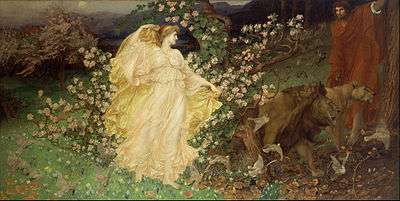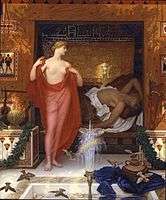William Blake Richmond

Sir William Blake Richmond KCB, RA, PPRBSA (29 November 1842 – 11 February 1921),[1] was a portrait painter and a designer of stained glass and mosaic, whose works include mosaic decorations below the dome and in the apse of St Paul's cathedral in London. He was the Slade Professor of Fine Art at the University of Oxford from 1879 to 1883.
Life
William Blake Richmond was born in 1842 in London. His father George Richmond RA (1809–1896), himself the son of Thomas Richmond (1771–1837), painted the portraits of the most eminent people of his day and played a part in society. He was named after a close friend of his father, the artist William Blake.
William received some coaching from Ruskin. In 1857 at the age of 14 he entered the Royal Academy schools, where he studied for about three years. A visit to Italy in 1859 gave him opportunity for studying the works of old masters and had an effect on his development. His first Academy picture was a portrait group (1861); and to this succeeded, during the next three years, several other pictures of the same class.
In 1864 Richmond's first wife died. The following year he returned to Italy, where he remained for four years, chiefly at Rome. During this time he met Frederic Leighton and the landscapist, Giovanni Costa; both of whom he admired. He painted the large canvas, A Procession in Honor of Bacchus, which he exhibited at the Royal Academy in 1869 when he came back to Britain.
In 1878 Richmond became Slade professor at Oxford University, succeeding Ruskin; but he resigned three years later.
Richmond's picture, An Audience at Athens (Birmingham Museum and Art Gallery), was exhibited at the Grosvenor Gallery, London in 1885. He was elected an Associate of the Royal Academy in 1888, and Royal Academician in 1895. He received the degree of D.C.L. in 1896, and a knighthood of the Order of the Bath in 1897, and became professor of painting to the Royal Academy.
Although he was a successful portrait-painter, Richmond wished to paint large, allegoric works, and this led him to take an interest in the design of stained glass and mosaic. He was elected to the Art Workers Guild in 1884, and became its Master in 1891. In decorative art his most conspicuous achievement was the internal decoration and the glass mosaics covering the spandrels and choir of St. Paul's Cathedral, London. A sequence of three large windows designed by Richmond, the earliest (1904) redesigned and remade when the second and third were added in 1910, can be seen in the Lady Chapel of Holy Trinity Sloane Street, London. Between 1899 - 1901, Richmond was elected as President of the Royal Birmingham Society of Artists.
Richmond also took a keen interest in social questions, particularly in smoke-prevention in London.
He was the father of Admiral Sir Herbert Richmond (1871–1946), a naval historian, and of Ernest Richmond (1874–1955), an architect.
%2C_by_William_Blake_Richmond.jpg)
 Hera in the House of Hephaistos
Hera in the House of Hephaistos Portrait of Mrs Ernest Moon
Portrait of Mrs Ernest Moon William Holman Hunt
William Holman Hunt
See also
- Environmental Protection UK – The modern form of the smoke prevention society founded by Sir William.
- North British Academy of Arts – Inaugural address.
References
-
 This article incorporates text from a publication now in the public domain: Chisholm, Hugh, ed. (1911). "Richmond, Sir William Blake". Encyclopædia Britannica (11th ed.). Cambridge University Press.
This article incorporates text from a publication now in the public domain: Chisholm, Hugh, ed. (1911). "Richmond, Sir William Blake". Encyclopædia Britannica (11th ed.). Cambridge University Press.
External links
- Paintings by William Blake Richmond at the Art UK site
- WB Richmond's Electra at the Tomb of Agamemnon (1874) used as a basis for a Punch cartoon about Oscar Wilde's departure to America.
-
 Works written by or about William Blake Richmond at Wikisource
Works written by or about William Blake Richmond at Wikisource - William Blake Richmond at Find a Grave